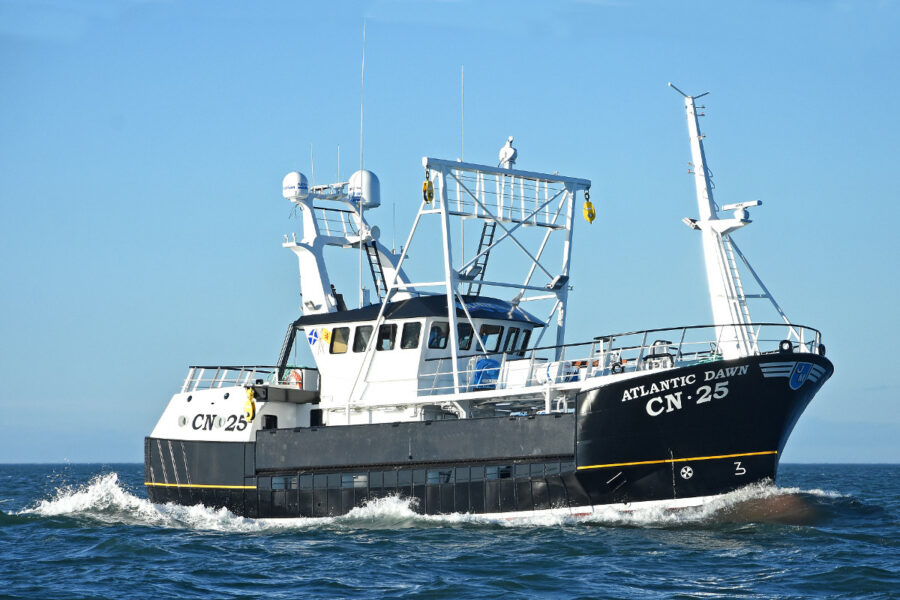20.3m automated scalloper is first boat to be built in Parkol Marine Engineering’s new premises on Teesside
The new scalloper Atlantic Dawn CN 25, built for James Monaghan of Islay Crab Exports Ltd by Parkol Marine Engineering, started fishing last week under the command of skippers Wayne Longden and Grant Lopez, reports David Linkie
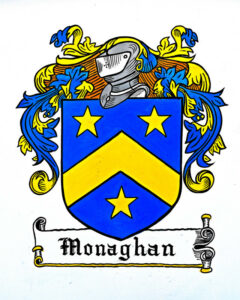 Designed to fish up to 12 dredges a side and incorporating a combination of well-proven and modern ideas in terms of fishing, hull and propulsion technology, Atlantic Dawn is the first vessel to be built and fully fitted out in Parkol’s new fabrication hall on Teesside. Up to four new boats can be in build at any one time in the new premises, which are served by three 20t overhead cranes, measure 70m by 35m, and have a height clearance of 40m.
Designed to fish up to 12 dredges a side and incorporating a combination of well-proven and modern ideas in terms of fishing, hull and propulsion technology, Atlantic Dawn is the first vessel to be built and fully fitted out in Parkol’s new fabrication hall on Teesside. Up to four new boats can be in build at any one time in the new premises, which are served by three 20t overhead cranes, measure 70m by 35m, and have a height clearance of 40m.
The large scale of the new premises meant that when Atlantic Dawn was moved onto the adjacent quay by Demag crawler units before being lifted into the river Tees, the masts and fishing gantries were already in situ.
Incorporating outer hull tipping doors and catch hoppers/conveyors, Atlantic Dawn also features four Caterpillar engines and a powerful package of deck machinery, custom-built by EK Marine of Killybegs.
Atlantic Dawn’s scallops will be collected at the point of landing for delivery to Islay, to be processed in-house by Islay Crab Exports Ltd. The new-build joins four more scallopers owned by MD James Monaghan – Crystal Dawn CN 20, Emerald Dawn BCK 303, Katie Claire CN 4 and Kayleigh M K 970.
James Monaghan said that the decision to build Atlantic Dawn was taken to maximise fishing efficiency, crew safety, fuel economy and catch quality.
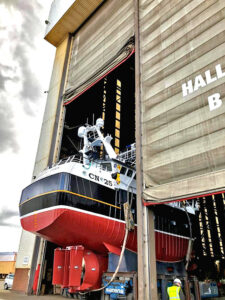
Atlantic Dawn marked the start of a new era for Parkol Marine Engineering by being the first boat the firm has built in its new premises on Teesside.
“The initial indications are that Atlantic Dawn will prove to be an efficient boat to run, not least in relation to fuel costs. Although we could have gone for a smaller, and therefore initially cheaper, main engine, a C32 ACERT unit was chosen and derated to suit the fishing licence. As a result, the engine was just ticking over when towing the gear up through the tide and weather on fishing trials, which bodes well for the future.
“In terms of the end product, I’m over the moon with Atlantic Dawn, not least because the boat was completed 10 weeks ahead of schedule, which is a superb achievement in itself. From the initial contact with Parkol, absolutely everything was A1; I couldn’t have asked for more. The workmanship is fantastic, and the best I’ve ever experienced.
“Parkol is a family-run business, and the personal touch was evident at every step of the way. The yard is an incredible place; the facilities are just amazing. I’m not planning on building another new boat any time soon, but if I was, Parkol would be my first and only choice.
“At the end of the day, though, it is important to recognise that irrespective of build quality, any boat is only as good as its skipper and crew. In that respect, I am extremely fortunate to have a great team of experienced skippers and crew, whose skill and unremitting effort were key factors in building Atlantic Dawn.”
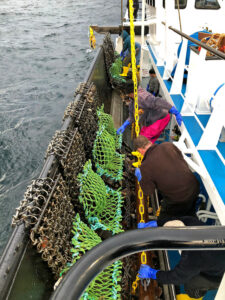
Tipping the starboard dredges for the first time on fishing trials.
Of round bilge hull form, Atlantic Dawn has main dimensions of LOA 20.3m, registered length 16.47m, beam 7.4m, depth moulded 4.6m, draft 5m and GT 141t.
Designed by Ian Paton of SC McAllister & Co Ltd, the hull incorporates aerofoil shaped anti-pitching fins towards the forefoot of the fully-formed bulbous bow, and a triple rudder system that immediately showcased its capabilities on sea trials, when Atlantic Dawn proved to be extremely manoeuvrable.
The ability to turn quickly and easily has always been viewed as being a key requirement for scallopers, particularly when working small areas of ground, when tight turns are commonplace.
The benefits of Atlantic Dawn’s triple rudder system are further enhanced by the presence of extendable towing arms, mounted on top of the steel shelterdeck and forward of the rudder stock, to give maximum efficiency.
This innovative arrangement, which first appeared on the similar-sized scalloper Summer Rose OB 141 – completed by Parkol Marine Engineering six months ago, after being developed by owner John MacAlister in close collaboration with Ian Paton and Eunan Kennedy of EK Marine – brings major advantages, in relation to both manoeuvrability and crew safety.
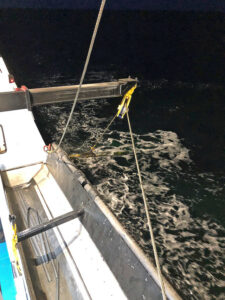
Hydraulically operated retractable towing arms enable the Gilson wires to be clicked in without the need to stand on the traditional style of towing arm.
Based on a similar principle to a telescopic crane boom, with one heavy steel box section sliding inside another, and operated by hydraulic rams controlled from the fishing consoles in the wheelhouse, the towing arms can be extended up to 2.5m from the sides of the hull.
This enables the arm on the inside of the turn to be retracted when turning during a tow, thereby bringing the fulcrum point closer to the hull to give maximum steering leverage.
In terms of safety, the retractable towing arms, which are located forward of the rudder stock, eliminate the need for crewmen to reach out over the side of the vessel when clipping in the Gilson hook, as the hanging block is easily brought to the side.
Deeside Marine manufactured the Durafish scallop dredges, now being worked 12 a side on Atlantic Dawn, in conjunction with outer hull tipping doors.
To ensure optimum levels of operational efficiency and safety, the full beam was kept parallel along the sides of the hull in the area where the tipping doors are positioned and the scallop dredges are worked.
Maintaining the vessel’s full beam forward to the shoulders also maximised the space available in both the catch-handling area and the hold.
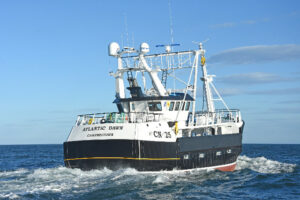
Starboard quarter view of Atlantic Dawn.
When the dredges are tipped, the contents drop down into stainless steel side reception hoppers, fabricated by EK Marine. Made wider than usual at the owner’s request, the hoppers incorporate heavy-duty conveyers, driven by hydraulically operated motors. In order to provide obstruction-free access for the crewmen standing in wells forward, picking scallop shells off the conveyor into baskets, the motors are located at the aft end of the reception hoppers.
Scallops and stones are moved forward through a small opening in an otherwise full-width deckhead arranged some 3m from the collision bulkhead. Stones left on the belt drop off the end for return to the seabed, via chutes lined with rubber to minimise noise levels.
Selected scallops are transferred to the fore end of the hold by a vertical stainless steel delivery pipe, from which they are bagged directly, prior to being stacked.
Capable of holding around 600 38kg bags of scallops, the hold is chilled by a powerful blower system centrally mounted on the deckhead, supplied by Autofreeze Ltd of Glasgow.
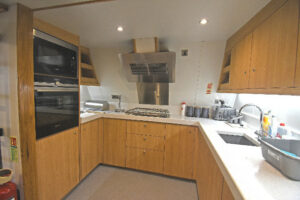
The well-equipped modern galley is arranged on the port side of the transom…
A 2.5t Sea Ice machine, manufactured by John White of Kilkeel, is mounted against the forward bulkhead in the hardwood-decked processing area. Flake ice drops vertically downwards to two ice lockers in the hold.
A key feature of Atlantic Dawn, which is insured by British Marine through Charles Cavanagh of Greencastle, is the amount of room and the resulting freedom of movement available on the main deck, on which only the main split trawl winches are positioned. The Gilson winches are located on the steel shelterdeck, while the pulling-down winches are mounted on the legs of the lifting gantry amidships.
By offsetting the fishroom hatch to port, the owners have created an obstruction-free main deck walkway from the deck casing to the enclosed catch-handling area forward, formed by creating an additional deck bulkhead aft of the collision bulkhead and forepeak store.

… with the spacious messdeck to starboard.
Immediate access is also available at shelterdeck level, where the wheelhouse is slightly offset to starboard, to create a walkway along the central part of the open shelterdeck down the portside of the wheelhouse.
Making maximal use of the space available is also a key feature of the deckhouse, the forward part of which is centrally positioned between the side reception hoppers and catch conveyors.
A well-equipped gear workshop is accessed directly from the aft end of the working deck. As well as leading to the main internal passageway in the deck casing, this working area also leads to a walk-in room to port, in which the computers for the wheelhouse electronic equipment, together with the electrical control panel for the deck machinery, are housed.
The spacious messdeck and galley area is arranged across the full width of Atlantic Dawn aft. Bench seating is arranged on three sides of two tables in the starboard messdeck. This is partly screened from the galley, which features the customary range of modern electrical appliances on three sides.
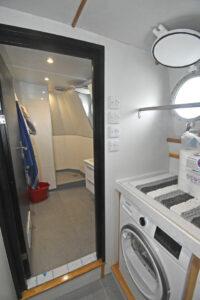
A large shower and washroom compartment is arranged on the aft port quarter of the deck casing, adjacent to laundry facilities.
A large shower/WC compartment to port, forward of the galley area, is accessed from a central area, which also leads to the aft cabin, engineroom and wheelhouse.
Below main deck level, the layout of Atlantic Dawn from forward follows the standard arrangement of forepeak, fish-hold, engineroom and accommodation.
Down the aft stair, the main accommodation cabin is subdivided to give two two-berth cabins to starboard, and a four-berth cabin along the port side of the hull. Every opportunity has been taken to maximise locker storage and bench seating for the comfort of the crew.
All internal accommodation areas on Atlantic Dawn are finished to an extremely high standard, using a combination of solid oak and matching light-coloured laminates to give an attractive and homely feel that is already appreciated by the crew.
Four Caterpillar engines from Finning UK
Finning UK supplied the four Caterpillar main and auxiliary power units installed in the engineroom of Atlantic Dawn.
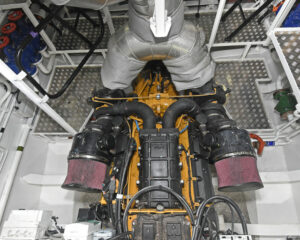
Caterpillar C32 ACERT main engine and Reintjes 7.4769:1 reduction gearbox.
Solely dedicated to propulsion duties, the Caterpillar C32 ACERT (Tier III) main engine develops 492kW @ 1,600/1,800rpm, and is coupled to a Reintjes WAF 374L 7.476:1 reduction gearbox.
The rationale for this choice of propulsion unit lies in the fact that the electronically controlled engine, which itself delivers improved fuel efficiency, features a wide operating speed range (WOSR) to deliver a flat power curve. This means that the engine can deliver full power while running at 1,600rpm to 1,800rpm, thereby enabling the large propeller to turn more slowly and provide enhanced propulsion efficiency.
As part of Atlantic Dawn’s fully-integrated hull and propulsion package, Ian Paton also designed the customised 2,300mm-diameter four-blade propeller and matching nozzle, which were fabricated by Parkol Marine Engineering. Fitted with lip seals, the sterngear was machined by Premier Engineering of Scarborough.
The centreline combination gave Atlantic Dawn an average top speed of 10 knots on engine trials.
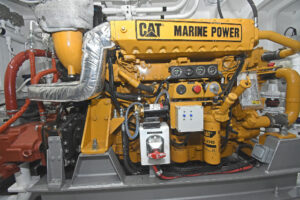
In addition to the C32 propulsion unit, Finning UK supplied the Caterpillar C12 variable-speed hydraulic engine…
A Caterpillar C12 variable-speed hydraulic engine drives the scalloper’s main load-sensing hydraulic system, in conjunction with a Technodrive splitter box and two Kawasaki pumps. Installation of the vessel’s hydraulic system was completed in-house by Parkol Marine Engineering, with stainless steel being used throughout.
Electrical power on Atlantic Dawn comes from two Caterpillar C4.4 auxiliary engines, each driving 100kVA Leroy-Somer 415/3/50 generators.
Three Victron 100 amp chargers serve the three sets of batteries in the engineroom. A similar Victron charger is situated in the wheelhouse to serve the lighting batteries, in addition to a 50-amp GNDSS charger.
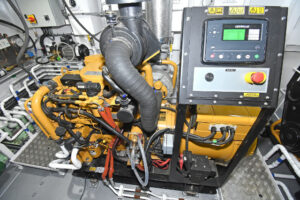
… and two C4.4 engines driving 100kVA electrical generators.
Pearson Electrical of Hull was subcontracted by Parkol Marine Engineering to undertake the electrical installation work on Atlantic Dawn, alongside the boatyard’s own electricians.
Cooling for the four engines and the hydraulics is provided through NRF box coolers, arranged across the forward end of the engineroom.
The arrangement of the engineroom on Atlantic Dawn is extremely well thought-out, ensuring maximum access for all levels of service in years to come.
A total of 20,000 litres of fuel is carried in two wing tanks in the engineroom and a double bottom tank under the fishroom floor. The bulbous bow houses 4,000 litres of freshwater.
EK Marine deck machinery and hydraulic package
Atlantic Dawn’s load-sensing hydraulic system and full package of deck machinery, including the outer hull tipping doors and catch conveyors, were custom-designed, manufactured and commissioned by EK Marine of Killybegs, in a significant first for the company.
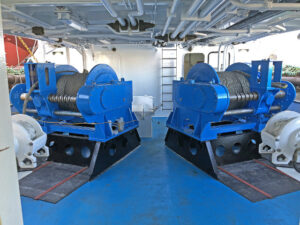
Two 20t split trawl winches were supplied by EK Marine of Killybegs as part of the scalloper’s full package of deck machinery and hydraulic system.
Central to the full package are three wheelhouse fishing consoles, two wing and one central, that enable the skipper to have full control of the complete shooting and hauling system, including operating the tipping doors and the retractable towing arms. The main central control panel, from which the skipper has a clear view of the trawl wires running over the hanging blocks on the end of the extendable towing arms, also provides a continuous read-out of the length of wire shot.
Shooting and hauling duties are handled by two split trawl winches, positioned forward on the main deck. Mounted on raised beds and hauling over the top of the large-diameter drums, the winches are angled slightly outwards to give straight leads over the top of the outer hull doors to the large-diameter hanging blocks, supplied by Flemings Fairleads, on the retractable towing arms. This arrangement will significantly reduce wear, and extend wire life, in the years ahead.
Rated 20t core pull, the winches are fitted with two-speed drive motors for faster hauling and shooting of the wire. The heavy-duty units were fabricated from special Hardox steel plate to give weight-saving benefits, and are fitted with high-specification SKF bearings and Hägglunds compact motors.
Two hundred and twenty-eight fathoms of 26mm-diameter trawl wire, supplied by Karl Thomson of Buckie, are accurately spooled on the drums at all times.
Two 10t Gilson winches are mounted on the shelterdeck, adjacent to the legs of the goalpost-style lifting gantry amidships. Two 3t pull-down winches are located on platforms welded to the tubular steel legs of the Gilson gantry, well above main deck level.
The 1t tipping winches, which will mainly be used when changing over dredges at sea during a trip, are mounted on short derricks towards the top of the main lifting gantry.
EK Marine also manufactured the 11m outer hull tipping doors, which were supplied as complete drop-in units. Pivoted at the gunwale rail and extending for more than half of the vessel’s length, these self-tipping doors are raised by two hydraulic rams mounted just inboard of the main deck scuppers. Considering that one set of scallop gear weighs nearly 2t, and that the contents of the dredges will often add a further 1t, the load being lifted by these rams is considerable. Manufactured from Hardox steel for maximum strength/weight benefits, the doors were sheathed with specialist heavy-duty rubber on completion of successful fishing trials, to minimise abrasion and paint discolouration.
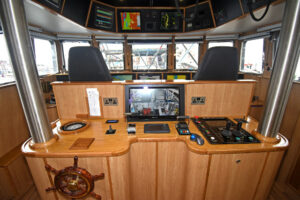
The central console…
On hauling, the scallop bars are positioned along the top outer edge of the catch hoppers, with the full dredges hanging down outboard. Metal teeth on the outer face of the doors engage in the specially extended bellies of the scallop dredges, to hold them in position against the doors as they are swung upwards through 170° to invert the dredges. Once the dredges are inverted, the crew shake each one to enable the contents to fall into the wide rectangular section hopper that extends the length of the scallop bars. After emptying, the raised side panels are lowered back into their recesses on the outside of the hull, allowing the gear to be shot away as usual.
A hydraulically operated slow-moving conveyor fitted at the bottom of each side hopper leads scallops and stones through openings in the fully-enclosed forecastle bulkhead to the catch-handling area. Standing in a recessed deck well that can be readily modified to suit different standing heights for maximum user comfort, a crewman selects scallops from the conveyor before stones and other debris are returned to the sea through side chutes. Generous provision is made for filled baskets of scallops, before they are transferred via a central chute down to the fishroom, for bagging in 38kg bags.

… incorporates a winch control panel supplied by EK Marine…
Bagged catches of king scallops are unloaded using an EK Marine 8m stiff-boom landing crane, positioned to port forward on the shelterdeck.
All the deck machinery on Atlantic Dawn is operated by two Kawasaki load-sensing pumps driven from a Technodrive clutch. This is mounted on a Caterpillar C12 variable-speed hydraulic engine developing 254kW @ 1,800rpm, which is mounted on the top of the port wing tank in the engineroom.
An electrically driven 35kW power pack provides back-up hydraulic power.
Electrotech Marine wheelhouse electronics installation
David Simcox of Electrotech Marine of Oban supplied, installed and commissioned the full package of electronic equipment fitted in Atlantic Dawn’s wheelhouse.
Sixteen AG Neovo monitors, including 12 19in screens, are flush-mounted in the well-arranged wheelhouse. Two tiers of monitors are housed in the streamlined main forward console, in front of two NorSap skipper’s chairs, positioned either side of a central island console.
Duplicate sets of engine/steering consoles and fishing consoles are positioned on shallow wing consoles.
A compass rose inlaid into the planked wood-effect flooring exemplifies the high quality of workmanship and the stylish finish of the wheelhouse, in which Solarglide screens are fitted to every window.
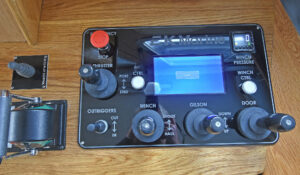
… with additional control stations located on the port and starboard consoles.
An office area, with two 17in monitors dedicated to vessel administration and the internet, is located in the after starboard corner of the wheelhouse, adjacent to the engine exhaust system housing. Tea/coffee-making facilities, together with a compact sink and fridge, are located to port.
The importance of accurate vessel positioning and ground discrimination for effective scalloping is shown by the high level of underwater acoustic sounding equipment and seabed plotting systems that skippers Wayne Longden and Grant Lopez are now using to provide optimum levels of information about the scalloper’s position relative to seabed contours.
A WASSP F3 160kHz Multibeam system is interfaced to a Furuno TimeZero plotter. Vertical bottom-sounding is handled by a Hondex HE-1500 sounder with hardness output interfaced into the 2/3D Olex plotting system.
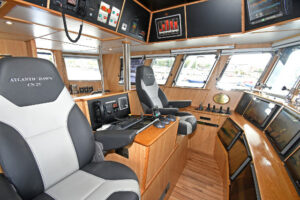
An extensive array of wheelhouse equipment was supplied and installed by David Simcox of Electrotech Marine.
The main radar is a Furuno FAR211BB model, backed up by a Halo broadband radar facility provided by a Simrad EVO2 Multifunction BB unit that also provides further bottom-sounding and plotting options.
A Furuno SC-70 satellite compass further enhances the performance of the Simrad AP70 autopilot system, which includes three joystick controls and two Simrad rudder angle indicators.
Eight of the X-19 screen displays are switchable via an 8 x 8 HDMI matrix, while a further four are dedicated to CCTV and Simrad EVO2 Multifunction.
All the flat-screen displays, computers and matrix were supplied by Four UPS Units.
Communications equipment includes a Sailor 6310 MF/HF GMDSS 150W radio telephone, two Sailor 6210 VHFs and a Jotron emergency GMDSS handheld VHF.
A wide-coverage CCTV system consisting of nine four-megapixel HD cameras and a 16-way HD VR was installed by Electrotech Marine. An HD through-hull propeller camera, with the facility to be withdrawn into the vessel for lens-cleaning, is also fitted.
Deeside Marine scallop dredges
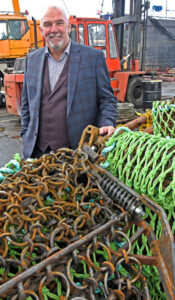
Richard Gidney of Deeside Marine, with the scallop dredges supplied by the Kirkcudbright company.
The Kirkcudbright company DSM Ltd supplied a full set of scallop gear to Atlantic Dawn, including everything from the end of the towing wires, plus spares and tools.
MD Richard Gidney said: “DSM is very proud to see the third of three new scallop boats this year rigged out with our gear. Summer Rose OB 141 is using our X10 bellies, Debbie V FH 555 our medium-weight Maxifish frames, X10 bellies and tooth bars, and now Atlantic Dawn our Durafish frames, X10 bellies and tooth bars.
“Islay Crab vessels have been using, and helping us develop, our Durafish frame for some time.
“It is a robust and medium/heavy frame designed to work in all types of ground. As usual, we have used several different types of steel to provide strength where necessary and abrasion-resistance in areas of wear. It is hand-built on jigs to provide optimum catchability, as opposed to using laser-cut parts for ease of manufacture.
“The Durafish frame is DSM’s latest development, and joins our family of frames, each of which is built to suit a variety of vessel sizes and ground types. They range from our lightweight Fastfish frame, suitable for smaller boats, to our Maxifish, which is a medium-weight frame (and our most popular), our Durafish, which is next in weight, our Superfish, which is a heavyweight frame and good for soft ground, and finally our Sumofish, a heavy, stout frame with great strength.
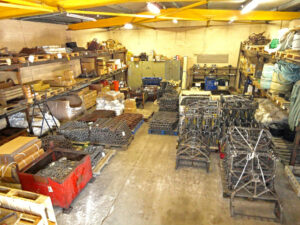
A well-stocked warehouse with scallop frames, chain bellies and swords, ready for delivery to a wide customer base in Britain as well as Europe, Canada and North America.
“DSM bellies continue to sell very well, and are proving popular across Europe, the USA and Canada, where we have sold many to the east-coast fishery, along with our N-Viro dredges.
“We manufacture all of our own rings and washers from steel which is made to our own specification, and to our own very tight tolerances; this allows us to get better, more accurate hardness into the finished product. The same is true of our sword teeth, which are also made from our own spec steel. We have looked at laser-cutting from Hardox, but we cannot get the same hardness from it, as it is a bulk-manufactured steel that simply does not have the tight tolerances of our own. Hardox was developed and patented many years ago by Swedish Steel, which makes thousands of plates and heat-treats them in bulk.
“DSM continues to develop and innovate, and enjoys working with our customers to develop new ideas, including spending time at sea to witness close-up how the gear is performing.
“Our workforce continues to grow year on year, and we are now a major employer in South West Scotland.”
To learn why ( I + FK ) x D = CS is key to successful scallop fishing, and for further QC information about DSM products, visit: deesidemarine.co.uk and nvirodredge.co.uk or call Davy on: 07918 715566, or Richard or Alison on: 01557 331407, or email: Deeside-marine@btconnect.com
Debbie V correction
In the feature on the new 12m scalloper Debbie V FH 555, owned by Amethyst Fishing Ltd (Fishing News, 18 October), it was inadvertently stated that Deeside Marine supplied the dredge frames only. This was incorrect, as the Kirkcudbright company supplied all of the scallop gear now being used successfully by Debbie V. Fishing News apologises for the error and the misunderstanding.
Islay Crab Exports Ltd
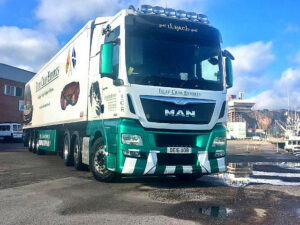
Islay Crab Exports vivier lorries deliver a wide selection of live shellfish to customers in Europe each week.
The family-owned company Islay Crab Exports Ltd has grown consistently since being established by James Monaghan in 1985.
Specialising in the marketing of live shellfish, Islay Crab Exports Ltd operates five vivier lorries which, after collecting live brown, green, spider and velvet crabs, lobsters, winkles, and surf and razor clams from an extensive catchment area, including Co Donegal, the Outer Hebrides, the west coast of Scotland and Caithness, deliver premium-quality shellfish and scallop meat to well-established outlets in Europe, including France, Spain and Italy.
In addition to exporting live shellfish, all catches of king scallops by Islay Crab Exports’ vessels are processed daily in the company’s factory at Port Ellen, Islay.
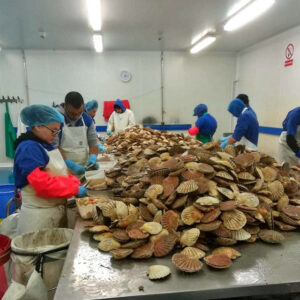
Processing king scallops in Islay Crab Exports’ premises on Islay.
Having initially focused mainly on creel-caught shellfish, Islay Crab Exports took the opportunity to diversify into catching and processing scallops with the purchase of the 14.9m wooden-hulled scalloper Christy M LH 30 from Islay skipper Archie McFarlane in 2005. This development was later strengthened when Christy M was sold to Carradale and replaced by the steel-hulled scalloper Germount K 970 from South Uist. This 13m vessel was renamed Kayleigh M, after James and Fiona Monaghan’s daughter.
The subsequent addition of the 18m scalloper Kelly BCK 625, in partnership with skipper Kris Duthie and Neil Cowie, led to Islay Crab Exports processing more scallops on Islay, where several local vessels also started landing to the company.
In order to maintain its development, Islay Crab Exports Ltd took over the former Islay Shellfish & Game processing factory in Port Ellen in 2011, from where premium-quality scallop meats are exported to Europe weekly.
Kayleigh M was subsequently joined by the 15m Crystal Dawn, the 20.8m Emerald Dawn (formerly Niamh Eoghan SO 934) and the 13.5m Katie Claire (formerly Twin B FD 407 and Katie Claire PZ 87).
Now sharing wheelhouse duties on Atlantic Dawn, Wayne Longden and Grant Lopez previously skippered Crystal Dawn and Katie Claire, which are now in the very capable hands of Patrick Ward and Steve Robertson.

